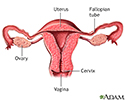Absent menstrual periods - secondary
Amenorrhea - secondary; No periods - secondary; Absent periods - secondary; Absent menses - secondary; Absence of periods - secondary
Absence of a woman's monthly menstrual period is called amenorrhea. Secondary amenorrhea is when a woman who has been having normal menstrual cycles stops getting her periods for 6 months or longer.
Causes
Secondary amenorrhea can occur due to natural changes in the body. For example, the most common cause of secondary amenorrhea is pregnancy. Breastfeeding and menopause are also common, but natural causes.
Women who take birth control pills or who receive hormone shots such as Depo-Provera may not have any monthly bleeding. When they stop taking these hormones, their periods may not return for more than 6 months.
You are more likely to have absent periods if you:
- Are obese
- Exercise too much and for long periods of time
- Have low body fat (less than 15% to 17%)
- Have severe anxiety or emotional distress
- Lose a lot of weight suddenly (for example, from strict or extreme diets or after gastric bypass surgery)
Other causes include:
- Drugs for cancer treatment
- Medicines to treat schizophrenia or psychosis
- Overactive thyroid gland
- Pituitary tumors
- Polycystic ovarian syndrome
- Reduced function of the ovaries
- Premature ovarian failure
Also, procedures such as a dilation and curettage (D and C) can cause scar tissue to form. This tissue may cause a woman to stop menstruating. This is called Asherman syndrome. Scarring may also be caused by some severe pelvic infections.
Symptoms
In addition to having no menstrual periods, other symptoms can include:
- Breast size changes
- Weight gain or weight loss
- Discharge from the breast or change in breast size
- Acne and increased hair growth in a male pattern
- Vaginal dryness
- Voice changes
If amenorrhea is caused by a pituitary tumor, there may be other symptoms related to the tumor, such as vision loss and headache.
Exams and Tests
A physical exam and pelvic exam must be done to check for pregnancy. A pregnancy test will be done.
Blood tests may be done to check hormone levels, including:
- Estradiol levels
- Follicle stimulating hormone (FSH level)
- Luteinizing hormone (LH level)
- Prolactin level
- Testosterone level
- Thyroid stimulating hormone (TSH)
Other tests that may be performed include:
- CT scan or MRI scan of the head to look for tumors
- Biopsy of the lining of the uterus
- Genetic testing
- Ultrasound of the pelvis or hysterosonogram (pelvic ultrasound that involves putting saline solution inside the uterus)
Treatment
Treatment depends on the cause of amenorrhea. Normal monthly periods most often return after the condition is treated.
A lack of menstrual period due to obesity, vigorous exercise, or weight loss may respond to a change in exercise routine or weight control (gain or loss, as needed).
Outlook (Prognosis)
The outlook depends on the cause of amenorrhea. Many of the conditions that cause secondary amenorrhea will respond to treatment.
When to Contact a Medical Professional
See your primary health care provider or women's health care provider if you have missed more than one period so you can get diagnosed and treated, if needed.
References
Bulun SE. Physiology and pathology of the female reproductive axis. In Melmed S, Auchus RJ, Goldfine AB, Koenig RJ, et al. Williams Textbook of Endocrinology. 14th ed. Philadelphia, PA: Elsevier; 2020:chap 17.
Cameron S. Menstruation and amenorrhoea. In: Magowan B, ed. Clinical Obstetrics and Gynaecology. 5th ed. Elsevier; 2023:chap 4.
Lobo RA. Primary and secondary amenorrhea and precocious puberty. In: Gershenson DM, Lentz GM, Valea FA, Lobo RA, eds. Comprehensive Gynecology. 8th ed. Philadelphia, PA: Elsevier; 2022:chap 36.
Review Date: 4/16/2024

















